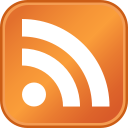
The near-universal symbol for RSS. If you see this symbol on a web page, it means that page offers an RSS feed.
Don’t you just love it when something has the words “really simple” in its name? It’s usually an indication that the exact opposite is true. But, in this case, you’ll find that RSS, Really Simple Syndication, is actually really simple.
So, what is RSS? RSS, which, as mentioned, stands for Really Simple Syndication, is a method of delivering regularly updated information over the web. Just think about the websites, blogs and other news information sources you visit everyday. It takes time to visit those sites and scour the ad-filled and image-heavy pages for just the text you want to read, doesn’t it?
Now imagine if you could visit all those information sources and web pages in just one place and all at the same time … without being bombarded with advertising… without having to search for new information on the page you’d already seen or read before… and without having to consume a lot of time visiting each site individually. Would that be valuable to you? Well, it’s available now through a “newsreader” and RSS.
A newsreader, sometimes called a news aggregator, is simply a software program, or more often, a website, that displays the content provided by RSS feeds. So, for example, if you use Google Reader as your newsreader, and you use RSS to send it the feed from the New York Times web page (this is called “subscribing to the feed”),you will be able to read stories from the New York Times, in Google Reader, and it will be updated continuously as new stories are published.
This lesson focuses on learning about RSS news feeds and setting up Google Reader — or, alternatively iGoogle — as a place to read the feeds from websites you regularly visit.
Video Tutorials
Definitely watch the first two; the third is optional.
RSS in Plain English
Google Reader Help Videos – There are six short videos on this page. Five of them will be useful to you. (You can skip the one about Craig’s List.)
How to Subscribe to an RSS Feed in iGoogle
Other Resources
Google Reader Help – pretty much everything you need to get started with RSS.
Reading RSS Feeds in Browsers and E-Mail
Often and web browsers (such as Internet Explorer or Firefox) and e-mail programs (such as Outlook or the Mail program on the Mac) have the ability to display RSS feeds. Here is some information on how to add RSS feeds to Internet Explorer 7 or 8, Firefox 3, and Mac Mail.)
- Using Feeds in Internet Explorer
- Using Feeds in Firefox – Firefox calls adding an RSS feed “creating a live bookmark.”
- Using Feeds in Mac Mail
Assessment
- Look at some feed readers. While there are several options as you’ve seen above, one of the most commonly used is Google Reader. For this exercise, let’s follow the Getting Started with Google Reader tutorial. You may have already seen this video; it’s one of the six videos in Google Reader Help Videos above. To get set up, just click on the link and follow the simple instructions!
- Try to add some blogs or websites to your feed reader. Grab the url’s for a couple of your favorite blogs and add them to your reader.
- Don’t have any favorite blogs or want some new reads? Check out the Top 100 Blogs as determined by Technorati.
- Using the sharing feature of Google Reader, share at least one blog post that you’ve read in the reader with Learning Path Assessment (assessment@johnjermain.org). See instructions for sharing, immediately below.
Sharing an item in Google Reader with a specific person, or group of persons is a two-step process. First, on the main reader screen you will see that beneath each item there is a “Share” button and also one labeled “Share With Note.” Click on either of these, depending on whether or not you want to add a personal note to the item you are sharing. Second: in the left column, under the “Persons You Follow” heading, find the words “Sharing Settings” and click on them. The Sharing Settings screen will open on the right side of the reader. Scroll down to the bottom of the sharing settings and you will see the words “Tell Some Friends.” Under the Tell Some Friends heading, find the word E-Mail and click on it. A box will open in the middle of the screen. Find the To: line and click on the box to right of the word To:. Then, type the e-mail address or addressess of the person or people with whom you wish to share this item. In this case type: assessment@johnjermain.org. Click OK, and you’re done.
Optional Challenge – Set up a personalized iGoogle homepage with feeds from various blogs and websites as in the How to Subscribe to an RSS Feed in iGoogle video above.
Reflections: Localize your Learnings
Ask Yourself
- How will using a feed reader change my web experience?
- How can I use a feed reader to optimize my professional development?
- Can we use RSS feeds to enhance a resource we are currently providing to our users?
- Do RSS feeds help us to think about a new set of resources we can provide to our users?
Comments on: "RSS Feeds" (2)
This was one of the easiest of all the tasks to complete
Interesting…didn’t know about this….We could help patrons to set up readers that are relavent to their interests…or possibly set up a library related reader with book reviews…or blogs about books.